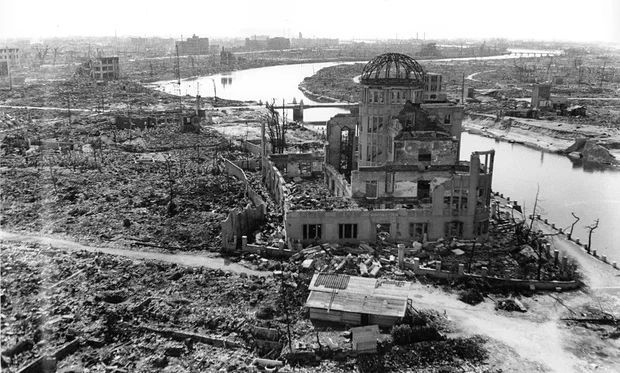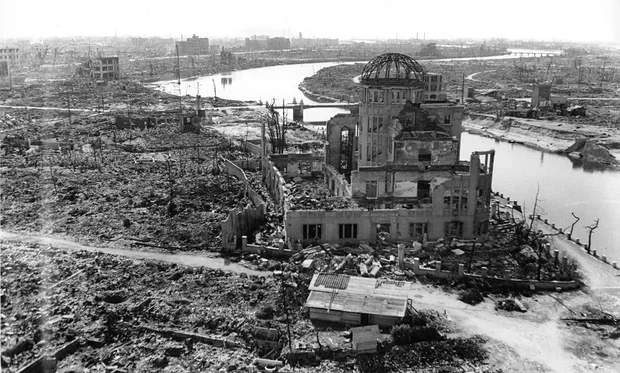P.J.
0
Hiroshima remembers the day the bomb dropped
Wednesday 5 August
The city fell silent as tens of thousands of people paid tribute to the victims and survivors of the world’s first atomic bomb
Bells tolled in Hiroshima on Thursday as tens of thousands of people gathered to mark 70 years to the day since the city was destroyed by an atomic bomb.

Japan’s prime minister Shinzo Abe and foreign delegates were among the tens of thousands who congregated at the Peace Memorial Park to observe a moment of silence at 8:15 am local time (2315 GMT), when the detonation turned the western Japanese city into an inferno.
The now-bustling city’s mayor Kazumi Matsui said nuclear weapons were an “absolute evil” as he urged the world to put an end to them forever.
“To coexist we must abolish the absolute evil and ultimate inhumanity that are nuclear weapons. Now is the time to start taking action,” he said in his speech.
Representatives of more than 100 countries, including the US ambassador to Japan, Caroline Kennedy, were among those marking the anniversary.
Standing in the shadow of the shell of what was then the prefectural industrial promotion hall – now known simply as the atomic bomb dome – they heard messages from survivors and local children and the city’s mayor.
Seven decades ago, the countdown to the first nuclear attack in history began in the early hours of 6 August 1945, when a US B-29 Superfortress bomber, escorted by two surveillance planes, took off from an airfield on the Pacific island of Tinian.
The Enola Gay, named after the mother of the plane’s pilot, Brig Gen Paul Tibbets, was carrying a 16 kiloton atomic bomb, nicknamed Little Boy; its target was Hiroshima, a port and major army base in western Japan, six hours’ flying time away.
As dawn broke in Hiroshima, its 340,000 residents were recovering from another sleepless night of false alarms after radar picked up a succession of US bombers flying overhead on missions further south.
Soon after 7am local time, a US weather surveillance aircraft escorting the Enola Gay triggered yet another air raid alert. The plane left the area and the all clear was sounded at 7.31am. Its message to the Enola Gay’s crew: “Weather good, possible to drop bomb.”
 Facebook Twitter Pinterest
Facebook Twitter Pinterest
A photograph taken by the US military shows the explosion as the bomb, nicknamed Little Boy, hits Hiroshima. Photograph: Hiroshima Peace Memorial Museum/EPA Forty-four minutes later, the Enola Gay released its payload. Below, people were preparing for an ordinary day at work, while young children set out for school, and older ones to factories to help Japan’s faltering war effort.
The city, the site of a large military headquarters, had so far been spared the heavy conventional bombing that had destroyed much of Tokyo and Osaka. Hiroshima residents were beginning to suspect that their city was next.
The bomb exploded 580 metres (2,000ft) above a T-shaped bridge at the junction of the Honkawa and Motoyasu rivers, unleashing a blinding flash followed by a deafening boom.
About 70,000 people died instantly in the blast or from the firestorms that raged moments later. The death toll would rise to about 140,000 by the end of 1945. The explosion, equal to 12,000 to 15,000 tonnes of TNT, destroyed more than two-thirds of Hiroshima’s buildings across five sq miles.

Hiroshima, including the prefectural industrial promotion hall, seen three months after the atomic bomb was dropped. Photograph: Hiroshima Peace Memorial Museum/AFP/Getty Images Within 45 minutes of the attack, nuclear fallout mixed with ash and smoke from the firestorms to create a radioactive black rain that soaked survivors and did not abate until the fires began to burn themselves out in the evening.
As people staggered among the dead and dying in search of water and medical treatment, news began to spread to the capital, Tokyo, that something unspeakable had occurred in Hiroshima.
But wartime leaders did not receive confirmation that the city had been destroyed by a nuclear weapon until the following day, when the US president, Harry S Truman, said: “Sixteen hours ago an American airplane dropped one bomb on Hiroshima. It is an atomic bomb.”
At 8.15am Hiroshima remembered its dead. This year, as on every other anniversary, the names of survivors – the hibakusha – who died in the previous 12 months will be added to the peace park’s cenotaph. On the eve of the 70th anniversary, the total stood at 292,325.
http://www.theguardian.com/world/2015/aug/05/hiroshima-prepares-to-remember-the-day-the-bomb-dropped
Wednesday 5 August
The city fell silent as tens of thousands of people paid tribute to the victims and survivors of the world’s first atomic bomb
Bells tolled in Hiroshima on Thursday as tens of thousands of people gathered to mark 70 years to the day since the city was destroyed by an atomic bomb.
Japan’s prime minister Shinzo Abe and foreign delegates were among the tens of thousands who congregated at the Peace Memorial Park to observe a moment of silence at 8:15 am local time (2315 GMT), when the detonation turned the western Japanese city into an inferno.
The now-bustling city’s mayor Kazumi Matsui said nuclear weapons were an “absolute evil” as he urged the world to put an end to them forever.
“To coexist we must abolish the absolute evil and ultimate inhumanity that are nuclear weapons. Now is the time to start taking action,” he said in his speech.
Representatives of more than 100 countries, including the US ambassador to Japan, Caroline Kennedy, were among those marking the anniversary.
Standing in the shadow of the shell of what was then the prefectural industrial promotion hall – now known simply as the atomic bomb dome – they heard messages from survivors and local children and the city’s mayor.
Seven decades ago, the countdown to the first nuclear attack in history began in the early hours of 6 August 1945, when a US B-29 Superfortress bomber, escorted by two surveillance planes, took off from an airfield on the Pacific island of Tinian.
The Enola Gay, named after the mother of the plane’s pilot, Brig Gen Paul Tibbets, was carrying a 16 kiloton atomic bomb, nicknamed Little Boy; its target was Hiroshima, a port and major army base in western Japan, six hours’ flying time away.
As dawn broke in Hiroshima, its 340,000 residents were recovering from another sleepless night of false alarms after radar picked up a succession of US bombers flying overhead on missions further south.
Soon after 7am local time, a US weather surveillance aircraft escorting the Enola Gay triggered yet another air raid alert. The plane left the area and the all clear was sounded at 7.31am. Its message to the Enola Gay’s crew: “Weather good, possible to drop bomb.”
 Facebook Twitter Pinterest
Facebook Twitter Pinterest A photograph taken by the US military shows the explosion as the bomb, nicknamed Little Boy, hits Hiroshima. Photograph: Hiroshima Peace Memorial Museum/EPA Forty-four minutes later, the Enola Gay released its payload. Below, people were preparing for an ordinary day at work, while young children set out for school, and older ones to factories to help Japan’s faltering war effort.
The city, the site of a large military headquarters, had so far been spared the heavy conventional bombing that had destroyed much of Tokyo and Osaka. Hiroshima residents were beginning to suspect that their city was next.
The bomb exploded 580 metres (2,000ft) above a T-shaped bridge at the junction of the Honkawa and Motoyasu rivers, unleashing a blinding flash followed by a deafening boom.
About 70,000 people died instantly in the blast or from the firestorms that raged moments later. The death toll would rise to about 140,000 by the end of 1945. The explosion, equal to 12,000 to 15,000 tonnes of TNT, destroyed more than two-thirds of Hiroshima’s buildings across five sq miles.

Hiroshima, including the prefectural industrial promotion hall, seen three months after the atomic bomb was dropped. Photograph: Hiroshima Peace Memorial Museum/AFP/Getty Images Within 45 minutes of the attack, nuclear fallout mixed with ash and smoke from the firestorms to create a radioactive black rain that soaked survivors and did not abate until the fires began to burn themselves out in the evening.
As people staggered among the dead and dying in search of water and medical treatment, news began to spread to the capital, Tokyo, that something unspeakable had occurred in Hiroshima.
But wartime leaders did not receive confirmation that the city had been destroyed by a nuclear weapon until the following day, when the US president, Harry S Truman, said: “Sixteen hours ago an American airplane dropped one bomb on Hiroshima. It is an atomic bomb.”
At 8.15am Hiroshima remembered its dead. This year, as on every other anniversary, the names of survivors – the hibakusha – who died in the previous 12 months will be added to the peace park’s cenotaph. On the eve of the 70th anniversary, the total stood at 292,325.
http://www.theguardian.com/world/2015/aug/05/hiroshima-prepares-to-remember-the-day-the-bomb-dropped

